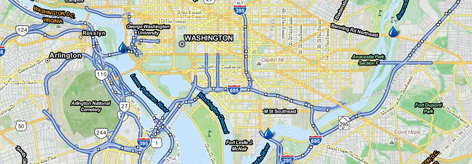DOEE's Anacostia River and Potomac River Monitoring provides information regarding the current water conditions of the Anacostia River and Potomac River in the locations displayed on the map below. Measurements include temperature, Dissolved Oxygen (DO), pH, depth, chlorophyll, and turbidity.

Click the map above to view real-time information. Follow the link and then click on the water drops on the map to find the station name and the most recent water quality readings for that site. New measurements are taken every 15 minutes. Click the “Site Details” link at the bottom of the box to search for previous water quality measurements. To find data from a specific time period, scroll to the Data History section and enter the desired date range.
To obtain data for long periods of time, please contact Jeffrey Zahn at [email protected].
Helpful Definitions for Real-Time Water Quality Monitoring:
- Dissolved Oxygen (DO)
DO is the amount of oxygen that is found in water and available to be used by aquatic organisms such as fish and shellfish. DO is a very important measure of water quality as low DO levels can stress organisms. In DC, the DO levels should range from 4.0 to 6.0 mg/L or greater, depending on the time of year. Warmer water cannot hold as much oxygen as colder water. - Water Temperature
Water temperature is the measure of how warm or cold water feels. If water temperatures fluctuate constantly aquatic organisms such as fish and shellfish will become stressed. Chronically stressful conditions may cause the aquatic organisms to relocate to an area with more suitable water temperatures. Water temperatures should not exceed 89° F. - pH
pH is the measure of acidity or basicity of water. The pH range most suitable for aquatic organisms is between 6 to 8.5. The pH scale ranges from 0 to 14. Neutral pH is 7. Acids have a pH value of less than seven, while bases have a pH value higher than 7. - Turbidity
Turbidity is a measure of water clarity. Clear water will have a turbidity measurement of 0 NTU. When materials such as clay, silt, organic matter, or microscopic organisms enter a waterbody, turbidity values increase and cause water to become cloudy and aesthetically unappealing. - Chlorophyll
Chlorophyll is a measure of the amount of algae (plants) in water. Chlorophyll is the main chemical responsible for photosynthesis in plants, the process by which sunlight is converted into food energy. Too much algae robs the water of adequate dissolved oxygen for other aquatic organisms survival. - Depth
The depth of water quality sensing devices located on the Potomac and Anacostia Rivers can change as a result of the tidal influence on the water bodies or an increase in flow due to precipitation.
View water quality reports and information regarding all District of Columbia water bodies:
Swimming
Swimming is prohibited in District of Columbia rivers and streams. However, rules were adopted in 2012 (Action to Amend the Ban on Swimming in the Potomac River, DCR Vol. 59 – No. 32, August 10, 2012) and 2018 (Anacostia River Special Swimming Events, DCR Vol. 65 – No. 31, August 3, 2018) that create exceptions to the prohibition of swimming in the District’s portion of the Potomac River and Anacostia River by authorizing qualifying swimming events for limited amounts of time under limited conditions. To learn more about how to obtain approval for a swim event.
E. coli: E. coli are bacteria that are used to indicate fecal contamination and the presence of pathogens in recreational waters. Exposure to pathogens can cause gastrointestinal illness with symptoms such as diarrhea, vomiting, stomachache, or nausea. The E. coli geometric mean standard (126 MPN/100 mL) is adopted from US EPA water quality standards.
pH: pH is the measure of acidity or basicity of water. The pH range most suitable for aquatic organisms is between 6 to 8.5. The Centers for Disease Control and Prevention (CDC) note that humans can experience skin and eye irritation when pH is below 7 or higher than 8.
Turbidity: Turbidity is a measure of water clarity. Clear water will have a turbidity measurement of 0 NTU. When materials such as clay, silt, organic matter, or microscopic organisms enter a waterbody, turbidity values increase and cause water to become cloudy and aesthetically unappealing.
The charts in the attachments section below display measurements taken from samples collected in the Potomac and Anacostia Rivers during summer 2022.
For More Information
- USGS Ground Water- Quality Data for the District of Columbia
- USGS Ground-Water Data for the District of Columbia
- USGS Real-Time Water Data for the District of Columbia
- DC Volunteer Water Quality Monitoring
For more information, please contact the Water Quality Division: (202) 535-2600

